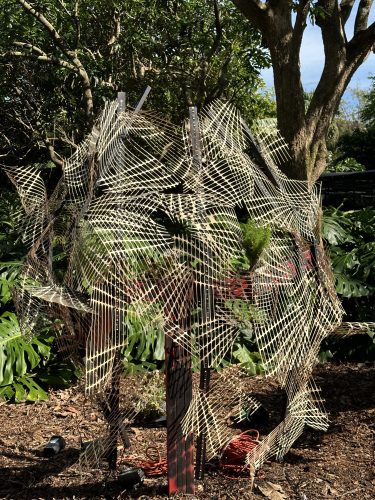Graduate students in the no.17 nationally ranked School of Architecture (SOA) are using their year-long graduate seminar course + design studio sequence as an opportunity to address sustainability in South Florida. 8 student groups were given the opportunity to partner with The Kampong of the National Tropical Botanical Garden and create permanent structures within The Kampong – the 9-acre garden housed in Coconut Grove and founded by famous botanist David Fairchild, utilizing the skills they’ve gained while in the Master of Architecture program.
“Working on this project was very hands on and enriching,” said Daniel Gonzalez. “Getting the chance to build something at a one to one scale with your own hands felt more personal and was full of a lot of lessons.”
“Facing the realities of construction and deadlines is very different when you’re putting in physical labor compared to when you’re designing something on a computer,” said his partner Tyler Oviedo. “Both me and Daniel Gonzales realized there is a joy to being hands on. We approached the design taking into consideration the key components of the structure and realized that we’d leave room for randomness and accidents in the forms that decorate the whole structure. Overall, it was a lot of fun.”

Their goal was to create sustainable pieces inspired by the biodiversity of the garden and provide a means for humans to engage with said biodiversity. Through thorough research of the plants and animals in the garden, the students decided to create structures that combine design and sound that immerse visitors into the natural environment. Their designs range from benches to walk-in structures and they are meant to create an awareness of the delicate lives of non-human inhabitants of the garden by providing experiences of reflection, contemplation and meditation – “structures for being in the moment” as Goldemberg describes them.
“Working with the Kampong on this project has been an eye-opening experience,” said Deepa Sampat. “Catering to a miniature yet expansive natural world allowed our group to rethink the process of pollination and the agents involved. We sought to respect both the wonderful environment maintained by the Kampong staff while creating habitats to be taken over by pollinators and plants.”
“Our project entitled Remnant evolved into a relationship between responsible decay and that which remains,” said partner Jadayne Smith, “Creating this structure was a worthwhile opportunity to learn and expand upon our skills as designers.”
“During this process, we learned new design technologies, explored fabrication techniques, studied textile crafts and experienced the challenges of producing a finished product,” said Romie Valencia, “We truly enjoyed seeing how this project progressed and evolved into what we have today.”

Under the guidance of Associate Professor and Digital Design Coordinator, Eric Goldemberg, they first chose a part of the garden for their inspiration, identified existing animal and vegetal species’ behaviors, studied the qualities of their habitats, and they extrapolated those characteristics into complex three-dimensional forms with elaborate textured materials. Along that process, they identified insects within the garden that can directly benefit as “pollinators” within the structure and created their designs with the surrounding plants growing into them over time. The students then made their designs come to life using eco-friendly materials such as wood, filament, and fabrics sourced from the FIU SOA Miami Beach Urban Studios (MBUS).
“This was an extraordinary opportunity for the students to be able to understand the intense process that goes from speculative drawings to making them a built, physical reality that will encounter visitors to The Kampong and enhance their curiosity, as well as the curiosity of the natural creatures that inhabit the garden” said Goldemberg, “This design-build project is the first phase of a more comprehensive plan that will allow the same group of students to evolve their designs into permanent structures for the garden pollinators, guided by the advice and feedback of The Kampong director Dr. Brian Sidoti and his staff.”
Professor Goldemberg noted that the very meaning of Kampong in several Asian languages refers to “village” and that is precisely what they are collectively building. The vision is village of art installations and furniture that will enhance the communication between humans and non-humans in this exuberant garden. In return opportunities are created for visitors to have a more intimate perception of the natural processes of the biodiversity that populates this former private estate that has become a treasure of Coconut grove.
In addition to the installation, the students partnered with professor Goldemberg’s design research practice MONAD Studio and musician-luthier Scott F. Hall to pair each structure with a 3d-printed instrument (sonic sculptures) to play an original music composition designed specifically for that space in the garden by Argentinian composer Pablo Fedele. The students will present their structures at the garden on December 6, where they will also be reviewed by guest jurors of industry professionals for a final grade. The presentations will also act as a fundraising musical event hosted by The Kampong so the students can expand their project through their final Spring semester.




